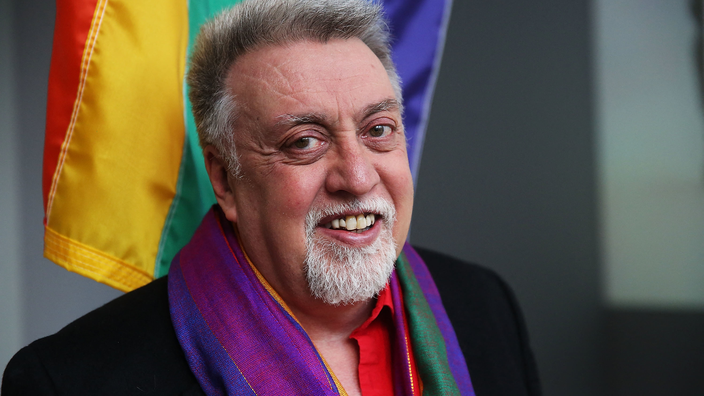According to
The Art Newspaper
, a fragment of the authentic "Rainbow Flag", designed by designer Gilbert Baker, who died in 2017, for the Gay and Lesbian Freedom Day Parade in San Francisco in June 1978 and lost since, has been recognized by the one of the vexillographers - a specialist in flags - who had worked with the artist.
The 9 by 18 meter banner, hand sewn and tinted in eight different colors, has become the rallying point of the Queer identity.
It was donated on June 4 to the LGBT History Museum in San Francisco, where it is now on permanent display.
To read also: At the Marche des Fiertés de Lyon, the "non-mixed" is the subject of debate
Gilbert Baker, then twenty-seven, worked at the Paramount Flag Company of San Francisco, a flag-making company. For the June 1978 march, he had created two monumental ones, with the help of volunteers and fellow artists such as Lynn Segerblom, James McNamara, Glenne McElhinney, Joe Duran and Paul Langlotz. Each of the fabrics was streaked with eight bands in the colors of the rainbow: pink for sex, red for life, orange for healing, yellow for the sun, green for nature, turquoise for magic and art, blue for serenity and purple for the spirit. Another version, with a square of tinted blue and white stars, had also been woven.
The demand for "Rainbow Flag" exploded after the assassination, in November 1978, of LGBT activist Harvey Milk, the first supervisor - equivalent of city councilor - of San Francisco, openly gay.
But the Paramount Flag Company could then only produce seven-stripe banners, as the cost of the rose was too high to allow its mass production.
In 1979, Baker modified the design a second time, removing the turquoise and keeping only six colors;
this is the version that history has retained until today.
To read also: TV program:
Harvey Milk
Late identification
"It was necessary to have the" Rainbow Flag "because until then we only had the pink triangle attributed by the Nazis
, recounted the artist in 2015, when the flag entered the collections of the Museum of Modern Art in New York (MOMA).
We needed something beautiful, something from us. The rainbow is perfect because it really matches our diversity in terms of race, gender and age. ”
The original prototypes were then stored in a community center in town, where they were partly eaten away by mold.
Baker was finally able to recover the still intact fragments and kept them until his death.
According to Charles Beal, president of the New York-based Gilbert Baker Foundation, the artist's belongings were returned to his sister at the time of her disappearance.
It was she who chose to entrust the eight-band standard to the Californian institution on the occasion of the 50th anniversary of the Stonewall riots in 2019. But we would have to wait for a vexillographer, James Ferrigan, to identify the object. to prove its historicity.
Read also: The Pride March sets off against a backdrop of bickering
The expert had worked with Baker at the Paramount Flag Company in San Francisco. He called Charles Beal to gather some information on this first rainbow flag, which he remembered seeing in Baker's apartment in San Francisco in the early 1980s. The flag was brought to him in San Francisco, where Ferrigan was able to identify the seams and grommets made at Paramount. An official expert report then said it was
"without a doubt"
the original. In June, the flag finally made its way to the LGBT History Museum, as the centerpiece of the current exhibition:
Performance, Protest and Politics: The Art of Gilbert Baker
.
“A flag is unlike any other form of art
,” Gilbert Baker said in his interview with MoMA in 2015.
It's not a painting, it's not just a fabric, it's not just a logo. It can work in so many different ways. When I designed it, I thought that we needed this kind of symbol, that we needed as a people something that everyone understands instantly ”
, hammered the artist.
“[The rainbow flag] doesn't say the word 'gay', like the American flag doesn't say 'the United States.' But everyone knows, visually, what he means. "

